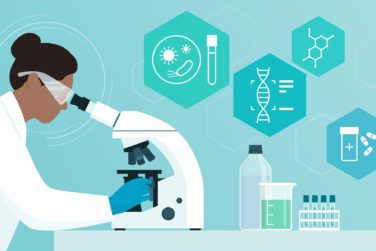The field of cell and gene therapy is making significant strides toward a day when human cells and genetic matter can be used to cure potentially fatal diseases and reverse degenerative conditions. Dedicated innovators are generating this wave of effective and often life-saving treatments, and together with their partners, are navigating uncharted territory as it relates to the development, testing, and commercialization of cell and gene therapies. The unique and complex nature—each therapy is comprised of living cells with a limited lifespan—of this class of drugs brings higher stakes and unprecedented pressures that are felt throughout the supply chain, approval pathway, and commercialization process.
Today, no “off the shelf” solution exists that brings all of the stages and processes together. However, experienced partners can work with innovators—particularly early in the development stages of these therapies—to help them anticipate challenges and customize cost-effective solutions that allow for a smooth transition from trial to market and commercial success.
Challenge: Clinical trial processes are more complex than ever before.
Solution: Select an experienced partner and define study parameters early.
Cell and gene therapies are at the forefront of medicine’s future. As a result, there is no step-by-step process for clinical trials. Each therapy—and, in some cases, each patient—needs a unique pathway developed. In the case of autologous therapies, the patient is an active part of the supply chain. As a result, these personalized therapies call for a personalized supply chain. As early as 12-18 months pre-transport, study parameters and performance markers should be identified.
First, sites of care need to be established. Location can present a number of additional hurdles, from customs issues to discrepancies in standards of care, which are often inconsistent across geographies. Because patient populations are smaller, trial candidates could be pulled from anywhere in the world. At the same time, cell and gene therapies are highly unique, time- and temperature-sensitive products that require seamless handling. The nuances from region to region are critical to keep in mind, and it’s important that an innovator’s logistics partner has both a global and regional perspective when designing its support. In fact, superior logistics coordination presents an opportunity to mitigate many of the regional challenges by establishing flexible solutions that can adapt to different countries, their specific regulations, and current infrastructures.
With a full understanding of the macro complexities of clinical trial design, innovators can begin working with their partners to drill down to the details: Coordinating specialized training, facilitating on-time rollout of the study and contingency planning. To do this, providers will need to be equipped to receive the cell or gene therapy, as planned and on time, and logistics partners need to be ready to deliver it in the same manner. Patients preparing for many cell or gene therapies often have to undergo additional procedures to ready their bodies for administration—such as chemotherapy to lower their immune systems. Clinical operations and logistics teams will need to develop custom, reliable solutions to ensure the therapy arrives at just the right time within the patient’s cycle of care.
Challenge: There is no room for error; logistics need to be executed near flawlessly.
Solution: Demand excellence, collaboration, and exceptional project management.
Flawless planning and execution are table stakes when it comes to ultra-sensitive, small patient population therapeutic transport. Any disruption or derailment can jeopardize a patient’s health and result in substantial system costs. Clinical trials for cell and gene therapies are an active process, as biologic matter is taken from the patient, transported to a lab, a treatment developed, and ultimately shipped back and re-administered to the patient for an autologous therapy.
Engaging an experienced and globally capable logistics partner with a proven track record of success is key to establishing a forward-looking, patient-centric plan rooted in interconnectivity at each touchpoint. Developing the project management plan is typically part of a four-step process:
- Assessment: Working collaboratively to identify key deliverables, milestones, performance metrics, and communications protocols.
- Design: Creating program components and their associated timelines.
- Implementation: Developing workflows, processes, policies, study-related standard operating procedures (SOPs), contingency planning, and instructional guides.
- Pre-operation: Launching a support program to maintain all parts of the trial from test shipments and tracking to kickoff meetings and ensuring communications work seamlessly.
Challenge: There is no distinct hand-off from clinical to commercial settings.
Solution: Leverage a partner with the resources and foresight to design a program that is flexible enough for both models.
Once study parameters and project management processes are instituted, they will be real-world tested. And despite all the planning, unforeseen challenges can always arise. When they do, a resourceful logistics provider has the experience and confidence to pivot, finding alternate solutions and guaranteeing the shipment’s integrity and delivery.
For example, if a product is traveling across international borders, pre-booked flights—coupled with pre-advised airline management and staff—can ensure that a product has maximum attention dedicated to it and all SOPs are strictly adhered to. Maintaining a dynamic chain of custody is crucial and adjustments may need to be made at a moment’s notice. Automated alerts from RFID or electronic trackers installed on the product container follow the shipment through its journey and allow for proper oversight at each stage. A specialized in-house study team can monitor each shipment, from pickup to delivery, to provide immediate response to any situation. Solutions such as GPS tracking and temperature monitors as well as sophisticated packaging can also be implemented.
Of course, though, like all things related to cell and gene therapies, logistics decisions cannot be made in a vacuum. Innovators and their partners must always be considering the other interdependencies, such as the connectivity between ordering, patient programs, manufacturing, and payment. No single piece of the puzzle works independently from another. But, the key learning that is already presenting itself in this emerging market is that if the right combination of expertise is brought to the table early enough, and every member at the table is willing to put the patient first, then these challenges can be overcome and produce life-changing results for patients.










